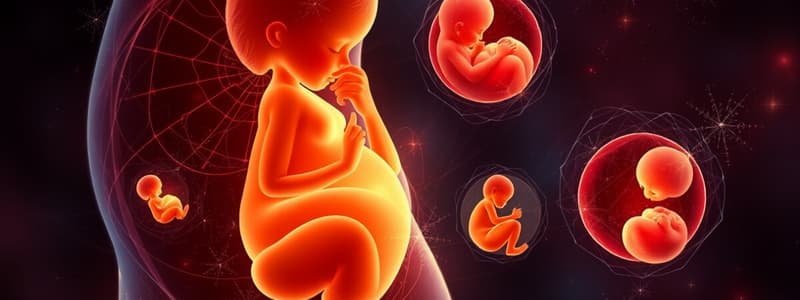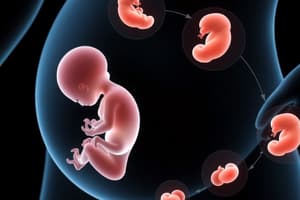Podcast
Questions and Answers
What is the primary focus of development during the 1st trimester of pregnancy?
What is the primary focus of development during the 1st trimester of pregnancy?
- Growth of the major body systems
- Development of the foundation of all major body systems (correct)
- Weight gain
- Maturation of body systems
At what stage of fetal development does implantation typically occur?
At what stage of fetal development does implantation typically occur?
- 2 weeks after conception
- 7-10 days after fertilization (correct)
- During fertilization
- At the end of the preembryonic stage
Which of the following components corresponds to the ectoderm in fetal development?
Which of the following components corresponds to the ectoderm in fetal development?
- Central nervous system and skin (correct)
- Musculoskeletal and urinary systems
- Circulatory and reproductive systems
- Respiratory and digestive system
How many chromosomes does a zygote possess after fertilization?
How many chromosomes does a zygote possess after fertilization?
What is the purpose of the umbilical cord during the embryonic stage?
What is the purpose of the umbilical cord during the embryonic stage?
What is the primary function of the Foramen Ovale in fetal circulation?
What is the primary function of the Foramen Ovale in fetal circulation?
What occurs to the Ductus Arteriosus after birth?
What occurs to the Ductus Arteriosus after birth?
How is blood shunted away from the lungs in fetal circulation?
How is blood shunted away from the lungs in fetal circulation?
What physiological change contributes to the closure of the Foramen Ovale at birth?
What physiological change contributes to the closure of the Foramen Ovale at birth?
What role does the Ductus Venosus serve in fetal circulation?
What role does the Ductus Venosus serve in fetal circulation?
What hormone is released to maintain the corpus luteum for progesterone production until the placenta takes over?
What hormone is released to maintain the corpus luteum for progesterone production until the placenta takes over?
Which of the following is a primary role of progesterone during pregnancy?
Which of the following is a primary role of progesterone during pregnancy?
What happens to hCG levels during the first weeks of pregnancy?
What happens to hCG levels during the first weeks of pregnancy?
Which hormone acts as an antagonist of insulin during pregnancy?
Which hormone acts as an antagonist of insulin during pregnancy?
At what stage of fetal development do all body systems begin to form?
At what stage of fetal development do all body systems begin to form?
Which hormone is primarily responsible for the enlargement of the uterus and breasts during pregnancy?
Which hormone is primarily responsible for the enlargement of the uterus and breasts during pregnancy?
What is the function of Relaxin during labor and delivery?
What is the function of Relaxin during labor and delivery?
What is the role of maternal prenatal supplements like folic acid during pregnancy?
What is the role of maternal prenatal supplements like folic acid during pregnancy?
What is the role of amniotic fluid in prenatal development?
What is the role of amniotic fluid in prenatal development?
Which condition is characterized by deficient levels of amniotic fluid?
Which condition is characterized by deficient levels of amniotic fluid?
What is one of the primary functions of the placenta?
What is one of the primary functions of the placenta?
Which of the following is NOT associated with oligohydramnios?
Which of the following is NOT associated with oligohydramnios?
Human Chorionic Gonadotropin (hCG) is primarily responsible for which function?
Human Chorionic Gonadotropin (hCG) is primarily responsible for which function?
What type of substances are teratogens?
What type of substances are teratogens?
What is the significance of Wharton's jelly in the umbilical cord?
What is the significance of Wharton's jelly in the umbilical cord?
What is a potential consequence of damage to the placenta?
What is a potential consequence of damage to the placenta?
At what gestational week does the placenta fully take over the function of the corpus luteum?
At what gestational week does the placenta fully take over the function of the corpus luteum?
Which statement accurately describes the development of the fetal brain and movement?
Which statement accurately describes the development of the fetal brain and movement?
What is the primary role of the ductus venosus in fetal circulation?
What is the primary role of the ductus venosus in fetal circulation?
Which developmental change occurs during Weeks 29-32 of gestation?
Which developmental change occurs during Weeks 29-32 of gestation?
What is the primary significance of the umbilical cord in fetal development?
What is the primary significance of the umbilical cord in fetal development?
What happens to lanugo towards the end of the gestation period, specifically during Weeks 33-38?
What happens to lanugo towards the end of the gestation period, specifically during Weeks 33-38?
How many umbilical arteries are present in the umbilical cord, and what is their function?
How many umbilical arteries are present in the umbilical cord, and what is their function?
Which of the following correctly describes the fetal lungs' development by Week 21-24?
Which of the following correctly describes the fetal lungs' development by Week 21-24?
Flashcards are hidden until you start studying
Study Notes
Fundamental Information
- Average human pregnancy lasts 40 weeks, beginning from the first day of the last menstrual period (LMP).
- Trimesters:
- 1st trimester: 0-13 weeks - foundation of major body systems.
- 2nd trimester: 14-26 weeks - growth and maturation of body systems.
- 3rd trimester: 27-40 weeks - primarily focused on weight gain.
- Definitions:
- Term: 37-42 weeks gestation.
- Pre-term: less than 37 weeks gestation.
- Post-term: greater than 42 weeks gestation.
- Estimated Gestational Age (EGA) refers to the estimated duration of the pregnancy.
Stages of Fetal Development
Stage 1: Preembryonic Stage (0-2 Weeks)
- Begins with fertilization, forming a zygote with 46 chromosomes.
- Zygote travels to the uterine cavity, entering about 72 hours post-fertilization.
- Implantation occurs 7-10 days after fertilization, typically at the uterine fundus.
- Cellular differentiation results in three germ layers:
- Ectoderm: Central nervous system, skin, glands.
- Mesoderm: Musculoskeletal, urinary, circulatory, and reproductive systems.
- Endoderm: Respiratory, liver, pancreas, and digestive systems.
Stage 2: Embryonic Stage (2-8 Weeks)
- Development of the umbilical cord and placenta begins.
- Umbilical cord contains one vein (carrying oxygenated blood to fetus) and two arteries (carrying deoxygenated blood to mother).
- Amniotic fluid serves multiple purposes:
- Provides cushioning, maintains stable temperature, and promotes symmetric development.
- Oligohydramnios (low amniotic fluid) linked to poor placental flow and fetal malformations.
- Hydramnios (excess amniotic fluid) may occur under certain conditions.
- Placenta functions:
- Acts as a barrier and filter, facilitating nutrient and gas exchange.
- Transfers antibodies from mother to fetus, providing immune protection.
- Teratogens negatively impact fetal development (e.g. syphilis, cytomegalovirus, drugs).
- Endocrine functions of the placenta include hormone production (e.g. hCG, estrogen, progesterone).
Stage 3: Fetal Development (9-40 Weeks)
- Focus on further growth and body system development; prenatal supplements like folic acid are essential.
- Key developmental milestones:
- Week 3: Formation of all body systems.
- Week 4: Detectable heart rhythm; neural tube closes.
- Week 6: Brain waves detectable; lungs begin to develop.
- Week 8: Fully formed heart; fetal structures start resembling humans.
- Week 12: Genital differentiation can be recognized.
- Week 20: Rapid brain growth; fetal heart tones detectable.
- Week 24: Surfactant production starts in the lungs.
Fetal Circulation
- The placenta acts as the "lungs" for the fetus, where blood remains separate.
- Structure of the umbilical cord: one vein for oxygenated blood and two arteries for deoxygenated blood.
- Three important shunts facilitate oxygen-rich blood to the fetal heart and brain:
- Ductus venosus: Shunts blood from the umbilical vein to the inferior vena cava.
- Foramen ovale: Allows blood to flow between the right and left atrium, bypassing the lungs.
- Ductus arteriosus: Connects pulmonary artery to descending aorta, redirecting blood away from the lungs.
Transition to Neonatal Circulation
- Upon cutting the umbilical cord, several changes occur:
- Ductus venosus closes.
- Fluid in the lungs releases, decreasing pressure and facilitating closure of foramen ovale.
- Removal of the placenta leads to closure of the ductus arteriosus due to changes in prostaglandin levels.
Studying That Suits You
Use AI to generate personalized quizzes and flashcards to suit your learning preferences.




